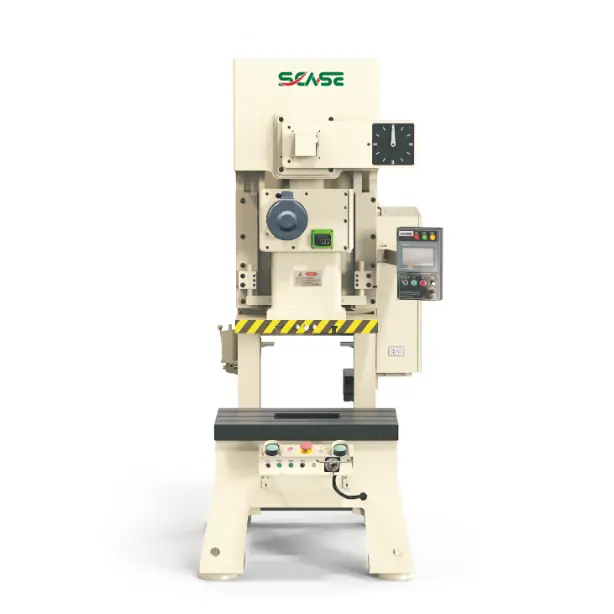Latest Advancements in C-Type Power Presses
C-Type Power Presses are advanced machines designed for precise cutting and shaping of metals and materials, making them indispensable in modern manufacturing environments. These presses are distinguished by their compact size, modular construction, and advanced automation features, perfect for industries like aerospace, automotive, and metal fabrication.
At the core of a C-Type Power Press is its gantry, carriage, and ram structure, which allows for precise control during the pressing process. This design ensures high-quality components with tight tolerances, a critical requirement for industries where precision is paramount.
Latest Advancements in C-Type Power Presses
Recent technological innovations have significantly enhanced the capabilities of C-Type Power Presses, making them more versatile and efficient. One of the most notable advancements is the integration of advanced control systems. These systems enable real-time monitoring and adjustment of pressing force, improving accuracy and reducing the risk of damage to the workpiece.
Another significant breakthrough is the development of precision machining. Modern C-Type Power Presses use high-precision tools and diamond dies, achieving ultra-accurate surface finishes and dimensional precision. This is particularly vital in sectors like automotive and aerospace, where precision is non-negotiable.
Automation has also made significant strides. Many C-Type Power Presses now feature robotic systems that handle the pressing process. This automation minimizes human intervention, reduces the risk of error, and increases efficiency and cycle times.

Impact of Technology on the C-Type Power Press Industry
The adoption of advanced technologies has transformed the production process in several ways. Increased efficiency is a key benefit, as automation and advanced control systems enable faster and more precise machining. This leads to higher productivity and lower operational costs.
Cost savings are another significant advantage. Automation reduces the need for skilled labor, lowering the overall cost of production. Additionally, the use of high-precision tools and dies minimizes scrap rates, further contributing to cost savings.
Customization is another important aspect. Manufacturers can choose presses tailored to their specific needs, whether it's the type of material, the required surface finish, or the cycle time. This customization makes C-Type Power Presses more accessible to a variety of industries.
Features and Benefits of C-Type Power Presses
C-Type Power Presses are modular, making them easy to maintain and upgrade. This flexibility allows manufacturers to reconfigure the press to suit different production needs, minimizing downtime and reducing the total cost of ownership.
Precision is a standout feature, with modern C-Type Power Presses capable of achieving extremely small pressing depths. This precision is crucial for producing components with tight tolerances, ensuring high-quality finished products.
Automation capabilities are another key benefit. Advanced control systems and robotic systems reduce human intervention, improving efficiency and minimizing errors. Real-time monitoring ensures optimal performance, optimizing energy usage and extending the lifespan of the equipment.
Real-World Applications
To better illustrate the benefits of C-Type Power Presses, let's look at a few real-world applications:
1. Automotive Industry: A leading automotive manufacturer uses C-Type Power Presses in their engine component production. These presses have significantly reduced the time required for producing pistons and cylinders, resulting in faster production cycles and lower scrap rates. For instance, a local factory reported a 20% reduction in cycle time and a 15% decrease in scrap material, translating to substantial cost savings.
2. Aerospace Industry: In the aerospace sector, C-Type Power Presses are used for producing lightweight and high-performance parts like turbine blades and airframe components. A prominent aerospace firm implemented C-Type presses and noticed a 30% improvement in production efficiency and a 25% reduction in material waste. This not only enhances performance but also reduces environmental impact.
3. Metal Fabrication Industry: In metal fabrication, C-Type Power Presses are used for producing structural components and decorative parts. A metal fabrication company adopted these presses and saw a 25% reduction in production time and a 10% increase in component precision. This improved efficiency has enabled them to take on more complex projects with higher standards.
Challenges and Future Trends
While C-Type Power Presses offer numerous advantages, they also present challenges. The complexity of their design can make them difficult to maintain and repair. High initial costs can be a barrier for smaller manufacturers, and the need for skilled personnel is another challenge.
Looking ahead, emerging technologies like artificial intelligence and machine learning are poised to further enhance the precision, efficiency, and automation of C-Type Power Presses. Future innovations are expected to drive the development of new features and capabilities, making these presses even more valuable to manufacturers.
Applications and Industries Utilizing C-Type Power Presses
C-Type Power Presses find applications in a wide range of industries. In the automotive industry, these presses are used for engine components like cylinders and pistons. In the aerospace industry, they produce lightweight and high-performance parts such as turbine blades and airframe components. In the metal fabrication industry, they are used for structural components and decorative parts.
Compared to other types of presses, C-Type Power Presses offer several advantages. Their modular design, advanced automation, and precision capabilities make them a more efficient and cost-effective solution for many manufacturing processes.
Conclusion
C-Type Power Presses are essential in modern manufacturing, offering precision, efficiency, and customization. As technology continues to evolve, these presses will play an increasingly important role in the production of high-quality, high-performance components. Whether in the automotive, aerospace, or metal fabrication industries, C-Type Power Presses are poised to revolutionize manufacturing.





